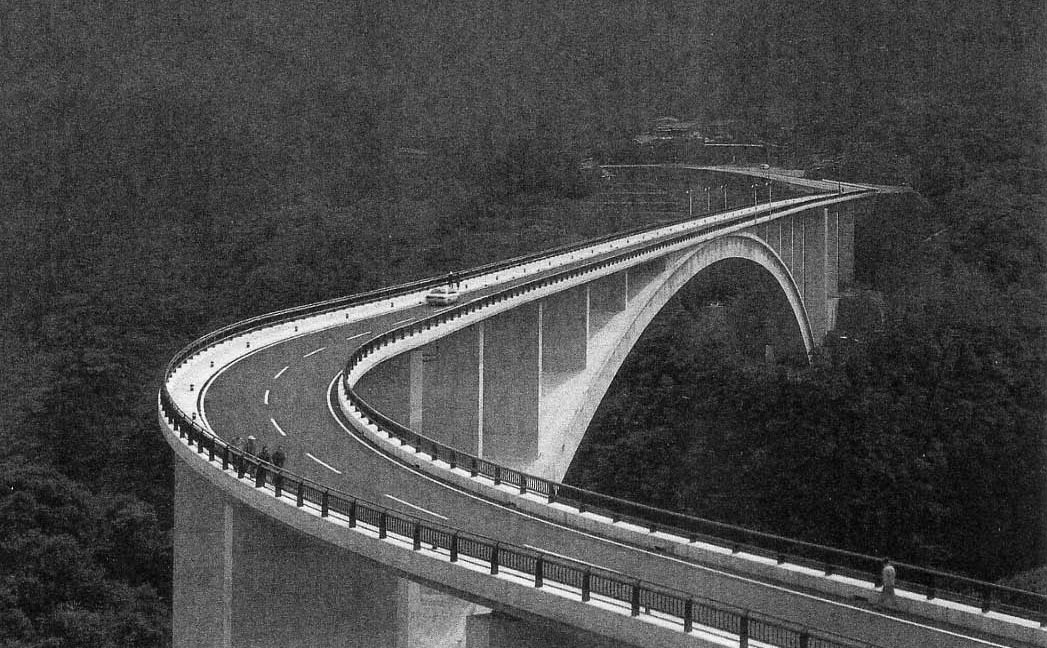Difference between revisions of "Tensho Bridge"
| Line 10: | Line 10: | ||
| − | The | + | The highest and longest concrete arch in Japan, the Tensho bridge soars across a forested river gorge in the mountains of southern Japan’s Miyazaki prefecture. The bridge is located just south of Takachiho Gorge, a region with more high bridges than any other single location in Japan. These include the highest railway bridge in Japan over the Takachiho gorge as well as the Shintotakachiho and Aoba concrete arches, the Unkai, Ryuten and Seiun steel arches and the Kamiiwato concrete beam bridge. All 8 bridges are more than 328 feet (100 mtrs) in height. If you have just one day to visit high bridges in Japan, Takachiho gorge is the place to be! |
| − | + | The construction of Tensho was somewhat different than similar sized arches whereby a tower is usually erected on either side of the gorge and cables temporarily radiate out from it to support individual sections of the arch until the two halves are joined in the middle. With Tensho, the roadway and support spandrels were built outward at the same time as the arch. To prevent the two halves of the arch from falling into the gorge, several cables were attached from an anchor to the road deck and then down to the arch segments. Once the next vertical spandrel support was built up to deck level and connected to another short span of roadway, then another diagonal cable was connected to the arch rib within the next spandrel and the process repeated itself. When the two sides of the arch were closed in the middle, the temporary cable stays were then removed from the inside of the spandrel panels. | |
| − | + | With a span length to rise ratio of just 8 to 1, the Tensho arch is so flat it looks lighter than its size would suggest. This desire to make the bridge an invisible presence is all part of the Japanese ethic to harmonize man and mother nature while maintaining the natural beauty of the environment. | |
| − | |||
| − | |||
Revision as of 04:36, 5 November 2009
Tensho Bridge
JapaneseName
Nishiusuki District, Miyazaki, Japan
470 feet high / 143 meters high
853 foot span / 260 meter span
2000
The highest and longest concrete arch in Japan, the Tensho bridge soars across a forested river gorge in the mountains of southern Japan’s Miyazaki prefecture. The bridge is located just south of Takachiho Gorge, a region with more high bridges than any other single location in Japan. These include the highest railway bridge in Japan over the Takachiho gorge as well as the Shintotakachiho and Aoba concrete arches, the Unkai, Ryuten and Seiun steel arches and the Kamiiwato concrete beam bridge. All 8 bridges are more than 328 feet (100 mtrs) in height. If you have just one day to visit high bridges in Japan, Takachiho gorge is the place to be!
The construction of Tensho was somewhat different than similar sized arches whereby a tower is usually erected on either side of the gorge and cables temporarily radiate out from it to support individual sections of the arch until the two halves are joined in the middle. With Tensho, the roadway and support spandrels were built outward at the same time as the arch. To prevent the two halves of the arch from falling into the gorge, several cables were attached from an anchor to the road deck and then down to the arch segments. Once the next vertical spandrel support was built up to deck level and connected to another short span of roadway, then another diagonal cable was connected to the arch rib within the next spandrel and the process repeated itself. When the two sides of the arch were closed in the middle, the temporary cable stays were then removed from the inside of the spandrel panels.
With a span length to rise ratio of just 8 to 1, the Tensho arch is so flat it looks lighter than its size would suggest. This desire to make the bridge an invisible presence is all part of the Japanese ethic to harmonize man and mother nature while maintaining the natural beauty of the environment.

